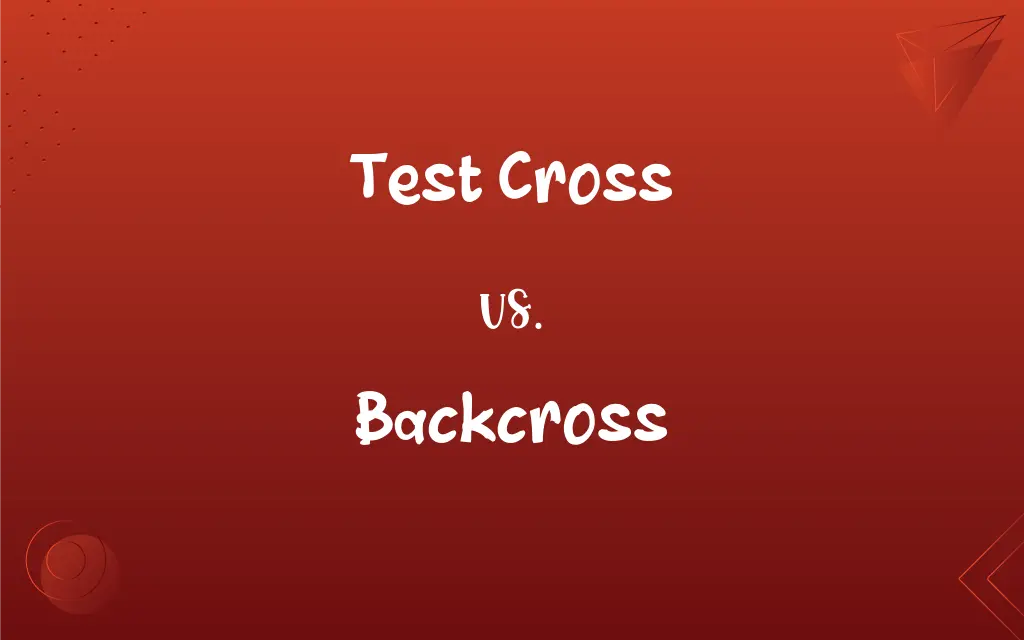Test Cross vs. Backcross: What's the Difference?
Edited by Janet White || By Harlon Moss || Updated on October 26, 2023
A test cross determines an organism's genotype using a homozygous recessive individual; a backcross involves crossing a hybrid with one of its parents.

Key Differences
In genetics, the concept of a test cross is critical for identifying the genotype of an individual exhibiting a dominant phenotype. In a test cross, this dominant-expressing organism is mated with a homozygous recessive individual. The resulting progeny's phenotypic ratio provides insight into whether the dominant-expressing parent was homozygous or heterozygous.
Backcross, on the other hand, is a cross between a hybrid organism and one of its parental genotypes. The goal of a backcross is often to produce offspring with a genetic makeup similar to the parent, allowing the breeder to retain a particular desirable trait. This method is particularly prevalent in plant breeding to retain specific genetic attributes.
The primary distinction between a test cross and a backcross lies in their objectives and the partners chosen for the cross. While the test cross aims to decipher the genotype of a dominant phenotype, the backcross focuses on achieving genetic similarity to one of the parents.
In practice, a test cross might involve crossing a tall pea plant with an unknown genotype with a dwarf pea plant to determine whether the tall plant is homozygous or heterozygous. A backcross, conversely, might involve crossing a hybrid pea plant with its tall parent to keep the tall trait in the offspring.
The significance of both the test cross and the backcross cannot be understated in genetics. While the test cross helps in uncovering genetic mysteries, the backcross aids in refining genetic characteristics to achieve specific breeding goals.
ADVERTISEMENT
Comparison Chart
Definition
Cross between an organism and a homozygous recessive individual.
Cross between a hybrid and one of its parents.
Purpose
Determine the genotype of an organism with a dominant phenotype.
Produce offspring similar in genotype to one parent.
Partner Chosen
Homozygous recessive individual.
One of the hybrid's parents.
Resultant Progeny
Reveals the genotype of the dominant phenotype organism.
Offspring with a genotype more like one of the parents.
Usage
Decipher genotype from phenotype.
Retain specific genetic traits in offspring.
ADVERTISEMENT
Test Cross and Backcross Definitions
Test Cross
A genetic cross to determine genotype.
The scientist used a test cross to uncover the pea plant's genetic makeup.
Backcross
A method aiming for offspring's genetic similarity to a parent.
The breeder used a backcross to ensure the dog's coat remained glossy.
Test Cross
A method to discern dominant phenotypes' genetic constitution.
Unsure of the mouse's genotype, they opted for a test cross.
Backcross
Genetic cross between a hybrid and a parent.
To retain the fruit's sweetness, a backcross was performed with the original parent.
Test Cross
A cross that decodes the genetic background of dominant traits.
The test cross results indicated the butterfly was heterozygous.
Backcross
Genetic cross for refining characteristics in offspring.
To enhance the crop's resistance, a backcross was initiated.
Test Cross
Genetic tool for genotype revelation.
Through the test cross, the unknown genotype was identified
Backcross
Cross designed to maintain specific genetic traits.
The rare color of the orchid was preserved using a backcross.
Test Cross
Mating involving a homozygous recessive partner.
To determine if the flower was homozygous, they conducted a test cross.
Backcross
Breeding strategy to align offspring genotype with a parent.
The backcross helped mirror the parent's disease resistance in the offspring.
Backcross
To cross (a hybrid) with one of its parents or with an individual genetically identical to one of its parents.
FAQs
Why is a test cross performed?
It's performed to determine whether an organism with a dominant phenotype is homozygous dominant or heterozygous.
How can the genotype of the dominant phenotype be determined using a test cross?
If all offspring display the dominant phenotype, the tested parent is homozygous dominant. If there's a mix of phenotypes, the parent is heterozygous.
How are test cross and backcross related?
Both involve breeding with a specific genotype, but for different purposes: determining an unknown genotype vs. retaining specific traits.
What is a test cross?
A test cross is a crossbreeding of an individual with a recessive homozygote to determine its genotype.
What is the usual phenotype of the partner in a test cross?
The partner is typically recessive homozygous, displaying the recessive phenotype.
Why is a backcross performed?
It's typically done to produce offspring with a genetic composition closer to one of the parents, often for breeding purposes.
In which cross is the F1 generation typically involved?
The backcross.
What is a backcross?
A backcross is the crossing of a hybrid organism with one of its parental genotypes.
How is a backcross different from a test cross?
While both involve breeding with a parent or a parental genotype, a backcross aims to retain certain desired traits, while a test cross determines an unknown genotype.
How is a backcross represented?
It can be represented as BC1, BC2, etc., with the number indicating the generation of the backcross.
How are test crosses and backcrosses used in genetic mapping?
Both can provide information about the distance between genes and their arrangement on chromosomes.
What is the main goal of each type of cross?
Test cross aims to determine an unknown genotype, while backcross aims to produce offspring with desired traits close to one of the parents.
What are the types of backcrosses?
(1) Backcrossing to the dominant parent (BC1) and (2) Backcrossing to the recessive parent.
Are test crosses and backcrosses only used in plants?
No, they are used in both plant and animal genetics.
Which cross helps in determining linkage of genes?
Both test crosses and backcrosses can help determine gene linkage.
Which cross uses a homozygous recessive partner?
The test cross.
What's the difference between a test cross and a self-cross?
A test cross mates an individual with a recessive homozygote, while a self-cross mates an individual with itself.
How can a backcross be used in animal or plant breeding?
It's used to incorporate specific traits from one parent into the offspring while maintaining the overall characteristics of the other parent.
Is backcrossing repeated?
Yes, it can be repeated several times to enhance or stabilize certain desired traits in the offspring.
Does backcross always ensure the desired trait is expressed in the offspring?
No, but repeated backcrossing increases the probability of obtaining the desired trait.
About Author
Written by
Harlon MossHarlon is a seasoned quality moderator and accomplished content writer for Difference Wiki. An alumnus of the prestigious University of California, he earned his degree in Computer Science. Leveraging his academic background, Harlon brings a meticulous and informed perspective to his work, ensuring content accuracy and excellence.
Edited by
Janet WhiteJanet White has been an esteemed writer and blogger for Difference Wiki. Holding a Master's degree in Science and Medical Journalism from the prestigious Boston University, she has consistently demonstrated her expertise and passion for her field. When she's not immersed in her work, Janet relishes her time exercising, delving into a good book, and cherishing moments with friends and family.































































